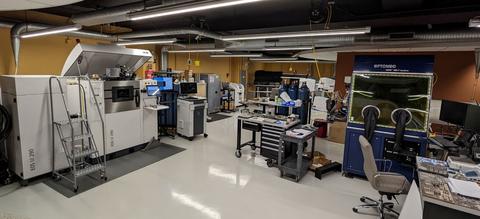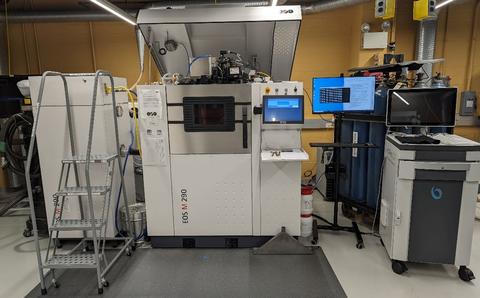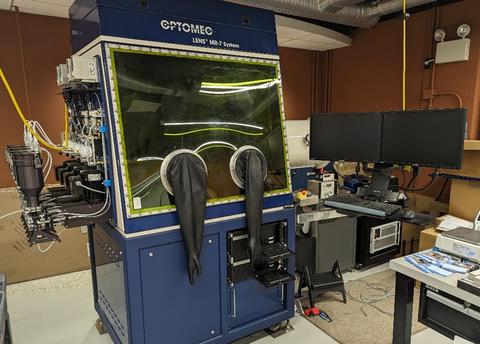Metal Additive Manufacturing (AM) Research Facility

The Metal Additive Manufacturing (AM) Research Facility is now called the Additive Manufacturing Research Center (AMRC).
Additive manufacturing gives U.S. manufacturers a rapid design-to-product capability to make complex, high-value, highly customized parts that are difficult or impossible to make with conventional manufacturing processes. Additive manufacturing systems provide an economic boost to U.S. manufacturers by shortening their product development cycle, increasing the quality and functionality of manufactured parts, enabling “personalized production” of customized manufactured product, and allowing on-demand fabrication of products where and when needed. Technical challenges include limitations in material types, indeterminate and non-uniform mechanical properties of the finished parts, difficult to ascertain process repeatability, insufficient part accuracy and surface finish, lack of consensus protocols and test data for qualification and certification, and underdeveloped non-destructive evaluation methods.
The NIST Additive Manufacturing Research Center (AMRC) is a state-of-the-art facility for conducting measurement science research for metals-based additive manufacturing. NIST research in this facility is focused on developing measurement science solutions for characterizing powders, processes, machines, and manufactured parts, as well as introducing process monitoring and control methods to improve the quality and reproducibility of the parts resulting from the processes.
The AMRC includes three industrial, metal-based AM systems, and space for planned additional machines, in addition to various consumer-level 3D printers, data processing computers, and attached conference room. These systems fabricate parts from metal powders using two different additive manufacturing processes: two systems use Laser-based Powder Bed Fusion (LB-PBF) and one uses Laser-based Directed Energy Deposition (LB-DED). Together, these machines support NIST research by providing an array of processing technologies that are representative of many of those used by industry today.
Overview of Equipment
200-Watt LB-PBF System
The uniquely-modified 200-watt LB-PBF system has the capability to build parts from stainless steel, aluminum, titanium alloy, nickel alloy, and cobalt-chrome powders in either a Nitrogen or Argon environment. This system has the following features:
• Standard STL data input from 3D CAD model
• 250 mm x 250 mm x 215 mm build volume
• Processes powders of approximately 40 μm median size
• Typical solid layer thickness 20 μm
• 200-watt Yb:fiber laser, 1070 nm center wavelength
• Adjustable laser focal spot size
Additional Metrology Instruments:
• Customized door with tilted window (≈ 45°) enabling access of high-speed thermographic camera
• Automated, indexable sample stage
• Cable feedthroughs for instrumentation

400-Watt LB-PBF System
The production-representative 400-watt LB-PBF system has the capability to build parts from stainless steel, aluminum, titanium alloy, nickel alloy, and cobalt-chrome powders in either a Nitrogen or Argon environment. This system has the following features:
• Standard STL data input from 3D CAD model
• 250 mm x 250 mm x 215 mm build volume
• Processes powders of approximately 40 μm median size
• Typical solid layer thickness 40 μm
• 400-watt Yb:fiber laser, 1070 nm center wavelength
Additional Metrology Instruments:
• Structured-light based surface topographic measurement system
• Laser co-axial melt pool monitoring system
• Cable feedthroughs for instrumentation
• Laser power and spot size characterization

500-Watt Powder Blown LB-DED System
The research-oriented 500-watt LB-DED machine utilizes four nozzles to blow metal powder into the laser-induced melt pool. The system is configured as a 3-axis system with an XY part table and Z-axis deposition head. Four powder hoppers allow for multi-material or functionally graded material deposition. The system is enclosed in a laser-safe and environment-controlled enclosure, with a sealed antechamber for part removal. This system has the following features:
• 500-watt Yb:fiber laser
• 300 mm x 300 mm x 300 mm work envelope
• 2 L metal powder per hopper
• Flexible path/position control of deposition
Additional Metrology Instruments:
• Laser co-axial dual-wavelength melt pool monitoring camera
• Laser co-axial CMOS-based melt pool monitoring camera

The Engineering Laboratory at NIST maintains multiple other laboratories and systems dedicated to additive manufacturing research in addition to those in the AMRC. These include the Additive Manufacturing Metrology Testbed, powder characterization laboratory, surface metrology laboratory, metallography laboratory, as well as heat-treat, EDM, and CNC part finishing capabilities. Further information about the research of the Measurement Science for Additive Manufacturing (MSAM) program of the NIST Engineering Laboratory can be found here.

